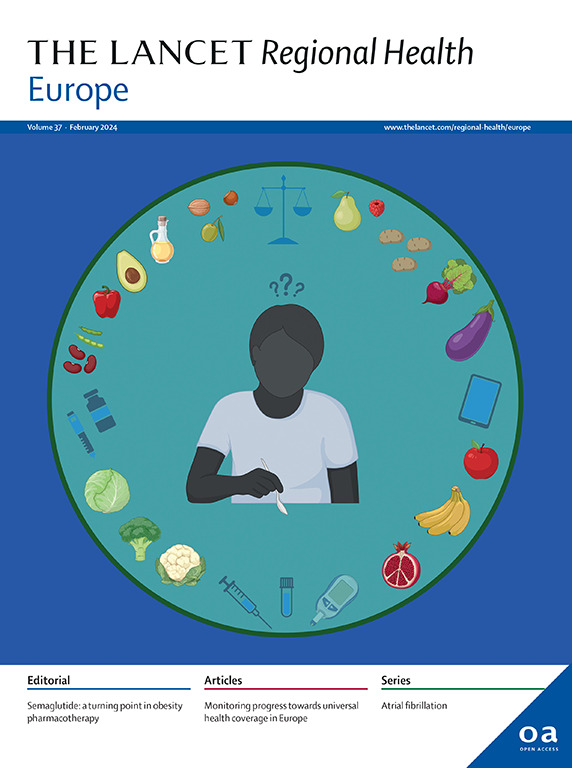Care and outcomes of first-time myocardial infarction among vulnerable populations in Denmark, 2003–22: a nationwide registry-based cohort study
IF 13
Q1 HEALTH CARE SCIENCES & SERVICES
引用次数: 0
Abstract
Background
Mortality following a first-time myocardial infarction (MI) has declined, yet disparities in treatment and outcomes among potentially vulnerable groups remain unclear. We aimed to examine trends in treatment and mortality among first-time MI patients from 2003 to 2022 across eight potentially vulnerable subgroups in Denmark.
Methods
Using Danish registries, patients with a first-time MI between 2003 and 2022 were identified and divided into five-year calendar groups and eight subgroups (‘age ≥80’, ‘low income’, ‘female’, ‘frail’, ‘non-Western immigrant’, ‘history of mental illness’, ‘living alone’, and ‘living in a rural area’). Temporal trends in treatment initiation and mortality were assessed using Kaplan Meier estimates and multivariable Cox regression.
Findings
Among 118,674 patients included, guideline-recommended therapy initiation increased over time, though gaps persisted (e.g. statin initiation in 2018–2022: 77.0% (2241/2911) among frail patients vs. 90.2% (19,986/22,157) among their counterparts). Crude and adjusted mortality rates declined for all subgroups over time, yet gaps persisted. Mortality remained highest among frail patients (5-year mortality risk of 48.7% [95% CI 46.5–50.9] in 2018–2022) and those aged ≥80 years (56.5% [95% CI 54.5–58.5]), no mortality difference was observed between patients living in rural areas and their counterparts (21.6% [95% CI 20.6–22.6] vs. 21.3% [95% CI 19.8–20.6] in 2018–2022), and non-Western immigrants exhibited lower mortality than their counterparts (8.8% [95% CI 7.0–10.6] vs. 21.3% [95% CI 20.7–22.0] in 2018–2022).
Interpretation
Despite improvements from 2003 to 2022, persistent disparities underscore ongoing inequities and the need for targeted efforts to promote equity.
Funding
None.
2003-22年丹麦易感人群首次心肌梗死的护理和结局:一项全国性的基于登记的队列研究
背景:首次心肌梗死(MI)的死亡率已经下降,但在潜在的弱势群体中治疗和结果的差异仍然不清楚。我们的目的是研究2003年至2022年丹麦8个潜在易感亚群中首次心肌梗死患者的治疗和死亡率趋势。方法使用丹麦的登记资料,对2003年至2022年间首次心肌梗死的患者进行识别,并将其分为5年日历组和8个亚组(“年龄≥80岁”、“低收入”、“女性”、“体弱”、“非西方移民”、“精神病史”、“独居”和“生活在农村地区”)。使用Kaplan Meier估计和多变量Cox回归评估治疗开始和死亡率的时间趋势。在纳入的118,674例患者中,指南推荐的治疗起始率随着时间的推移而增加,但差距仍然存在(例如,2018-2022年虚弱患者的他汀类药物起始率为77.0%(2241/2911),而对照组为90.2%(19,986/ 22157))。随着时间的推移,所有亚组的粗死亡率和调整死亡率都有所下降,但差距仍然存在。虚弱患者(2018-2022年5年死亡风险为48.7% [95% CI 46.5-50.9])和年龄≥80岁的患者(56.5% [95% CI 54.5-58.5])的死亡率仍然最高,农村地区患者与同行的死亡率没有差异(2018-2022年21.6% [95% CI 20.6-22.6]对21.3% [95% CI 19.8-20.6]),非西方移民的死亡率低于同行(2018-2022年8.8% [95% CI 7.0-10.6]对21.3% [95% CI 20.7-22.0])。尽管从2003年到2022年有所改善,但持续存在的差距凸显了持续存在的不平等,需要有针对性地努力促进公平。
本文章由计算机程序翻译,如有差异,请以英文原文为准。
求助全文
约1分钟内获得全文
求助全文
来源期刊

Lancet Regional Health-Europe
Multiple-
CiteScore
19.90
自引率
1.40%
发文量
260
审稿时长
9 weeks
期刊介绍:
The Lancet Regional Health – Europe, a gold open access journal, is part of The Lancet's global effort to promote healthcare quality and accessibility worldwide. It focuses on advancing clinical practice and health policy in the European region to enhance health outcomes. The journal publishes high-quality original research advocating changes in clinical practice and health policy. It also includes reviews, commentaries, and opinion pieces on regional health topics, such as infection and disease prevention, healthy aging, and reducing health disparities.
 求助内容:
求助内容: 应助结果提醒方式:
应助结果提醒方式:


